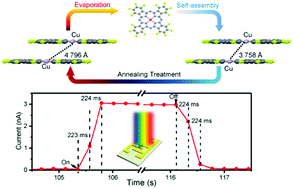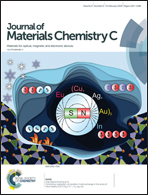Crystal structure tuning in organic nanomaterials for fast response and high sensitivity visible-NIR photo-detector†
Abstract
A new polymorph of copper hexadecafluorophthalocyanine, η-F16CuPc, was fabricated via organic vapor phase deposition. The crystal structure, morphology and optical properties of η-F16CuPc were characterized by X-ray diffraction, scanning electron microscopy, Fourier-transformed infrared spectroscopy and UV-Vis spectroscopy. Moreover, the phase transitions of F16CuPc from the η- to the β-phase were investigated by thermogravimetric analysis (TGA) and differential scanning calorimetry. In addition, the visible-NIR photodetectors based on F16CuPc nanowires were fabricated and their photo-response features were systematically studied. The absorption spectra of η-F16CuPc exhibited a broad band in the visible and near-infrared (NIR) regions, extending to a wavelength of ∼900 nm. The η-F16CuPc photodetector exhibited a fast response even at a low bias voltage of 0.5 V under a solar simulator with a power of 100 mW cm−2. The photocurrent response rise/fall time of the photodetector was ∼448 ms under various irradiation wavelengths. This organic-based photodetector also performed well for near-infrared light with wavelengths up to 940 nm.



 Please wait while we load your content...
Please wait while we load your content...